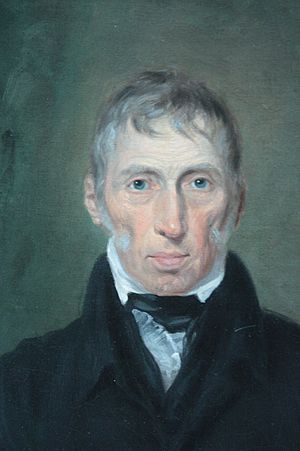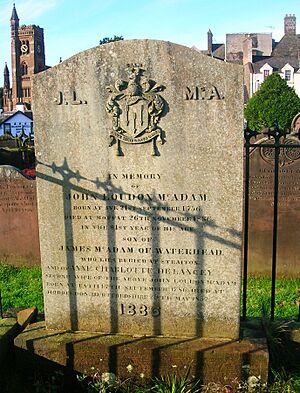John Loudon McAdam facts for kids
Quick facts for kids
John Loudon McAdam
|
|
|---|---|

John McAdam
|
|
| Born | 23 September 1756 Ayr, Scotland
|
| Died | 26 November 1836 (aged 80) Moffat, Dumfriesshire, Scotland
|
| Nationality | Scottish |
| Citizenship | Scottish |
| Occupation | Engineer |
| Engineering career | |
| Significant advance | "Macadamisation" |
John Loudon McAdam (born September 23, 1756 – died November 26, 1836) was a clever Scottish engineer. He invented a special way to build roads. This new method, called "macadamisation," made roads smooth, strong, and much less muddy. It used carefully chosen stones of different sizes.
Even today, how we build roads is still inspired by McAdam's ideas. One big improvement later on was adding tar (like sticky black glue) to hold the stones together. This created what we now call "tarmac" (short for Tar Macadam).
McAdam's Early Life
John McAdam was born in Ayr, Scotland. He was the youngest of ten children. When he was young, he moved to live with his grandparents. His family's original name was McGregor, but they changed it to McAdam for political reasons a long time ago.
In 1770, when he was about 14, John moved to New York. He worked as a merchant, helping to buy and sell goods. He became quite wealthy while working for his uncle, William McAdam.
John returned to Scotland in 1783. He bought a large piece of land called an estate in Ayrshire. He also managed a coal mine called Kaims Colliery. This mine supplied coal to a company that made coal tar. This was John McAdam's only direct connection to tar.
Building Better Roads
In 1783, McAdam became involved with the Ayrshire Turnpike. This was a group that managed roads and collected tolls (fees) to pay for their upkeep. Over the next ten years, he became very interested in how roads were built.
In 1802, he moved to Bristol, England. By 1804, he was the main surveyor for the city. A surveyor is someone who studies and plans land for building. McAdam shared his ideas with the British Parliament several times. He also wrote two important books about road building.
In his books, McAdam explained that roads should be higher than the ground around them. They should also be built with layers of rocks and gravel. In 1816, he started rebuilding roads in Bristol using his new method. He used crushed stone mixed with gravel on a strong base of larger stones.
He also made the roads slightly curved in the middle, like a gentle hill. This curve, called a camber, helped rainwater drain off quickly. This stopped water from soaking into the road and damaging its foundation. This smart way of building roads was the biggest improvement since Roman times. It became known as "macadamisation" or simply "macadam".
McAdam's road-building method quickly became popular around the world. The first macadam road in North America was built in the 1830s. By the late 1800s, most major roads in Europe used McAdam's process.
John McAdam was paid well for his work. In 1820, he became the "Surveyor-General of Metropolitan Roads." However, some people were jealous of his success. His efficient work also showed that some road groups were misusing the money they collected from tolls.
Later Life and Family
John McAdam passed away in Moffat, Scotland. He was on his way home from his yearly summer visit to Scotland. His three sons and four grandsons followed in his footsteps. They also became involved in managing roads across the country.
His second son, James Nicoll McAdam, was even knighted for his work. He was sometimes called the "Colossus of Roads." It is said that his father, John, had been offered a knighthood too, but he turned it down.




